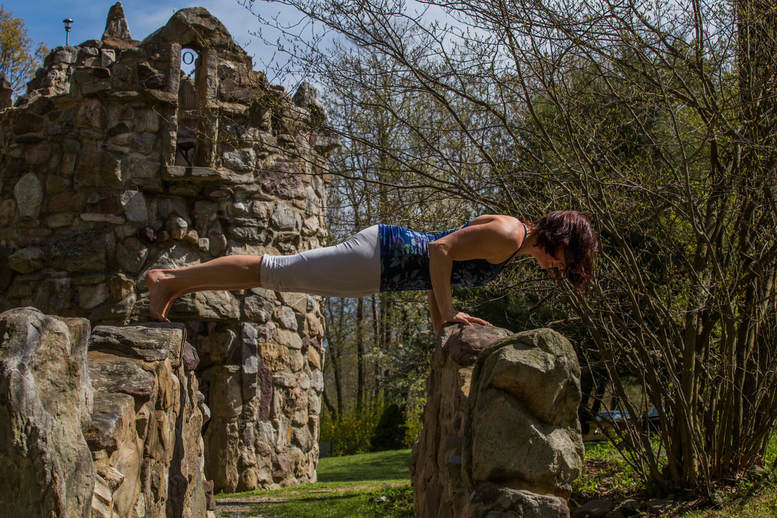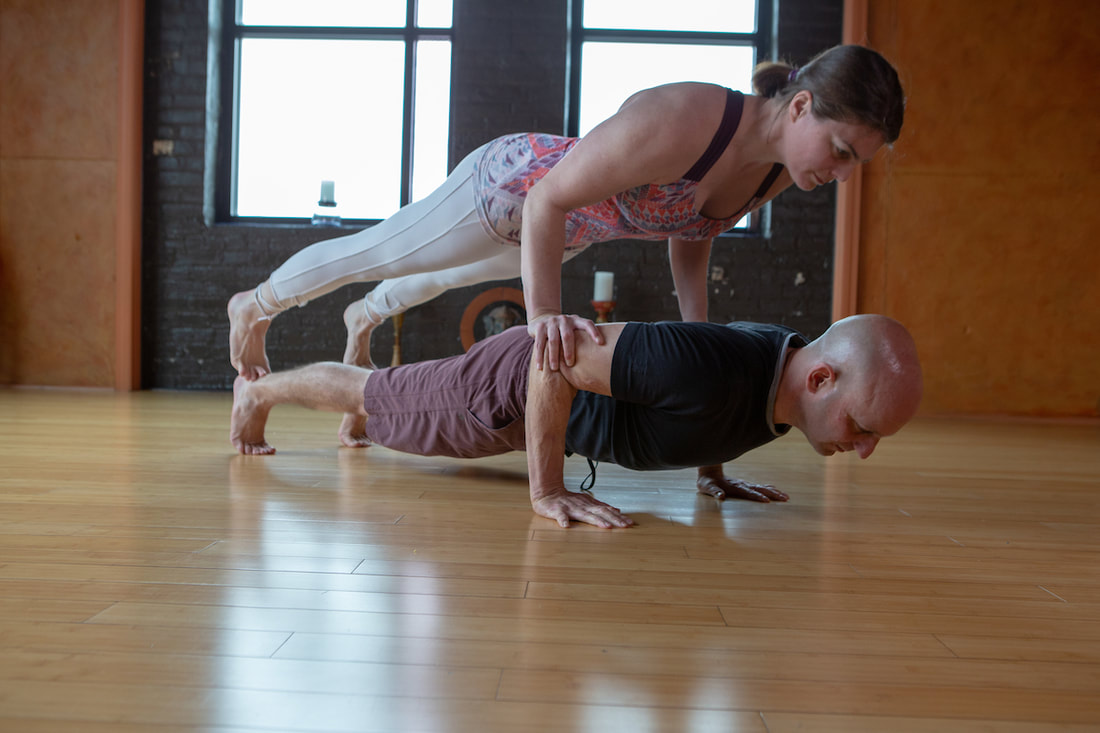|
Most people know that a benefit of yoga is increased flexibility, but many have not yet realized how important the strength side is to their bodies and how yoga can help. Welcome to the pose chaturanga dandasana or four limb staff pose.
Chatur — four Anga- Limb Danda — staff Asana — pose Chaturanga dandasana is an incredible posture for building balance, good posture and shoulder, core, thigh and leg strength. This posture is commonly seen in flow (vinyasa) classes. The downside is that many students do not really see this as a posture but use it as a transition to get from plank to up dog. If the transition is done with full awareness of the alignment of the pose and moved through with control the entire transition becomes a powerful strength building combo. If the transition is done without awareness of the alignment of the pose the transition losses its skillful nature and turns into a potentially damaging situation for the shoulders. It is important to note that no posture is good or bad, but our application of the poses may be skillful and supportive, or less than skillful and potentially problematic. In order to harness the incredible potential of this posture let's look at a points. In the photo above I was holding for about a minute as photographer Joe Longo got the photo. Chaturanga at first glance looks like a push-up. Technically it is a type of push-up, however there are a few things of note. 1. The elbows are close to the waistline (a traditional push-up would have the elbows almost inline with the shoulders). 2. The elbow are stacked over the wrists. (It is a common mistake to have the hands under the shoulders rather than the elbows) 3. The shoulders only lower to the same height as the elbows. (Going lower with the chest in this position is a major cause of repetitive stress to the rotator cuff and can manifest as a burning or sharp sensation at the head of the arm-bone on the front of the body. If you have such pain at this time I recommend skipping this posture and checking with a qualified medical professional) 4. We typically lower into the posture (training the negative) or hold the posture (isometric contraction) rather than lifting and lowering in repetition like a regular push-up (not that you couldn't, but it is not the usual mode for a flow class). Since the elbows are in line with the waistline and not the shoulders this decreases the recruitment of the pectorals and increase the workload on the triceps and upper-back muscles to keep the chest lifted. AS we lower the body down from a plank posture into chaturanga we are lengthening the triceps while they are contracting (eccentric contraction or training the negative). For students who are newer to this posture there can be a tendency to collapse into the shoulders as the chest lowers. Until the student builds enough strength,I recommend two things that can be helpful to train more safely, 1. Lower the knees to the ground to reduce the leverage of the body and thereby reducing the weight bearing load on the shoulders. 2. Lower down only as far as you can hold good form. There is no yoga rule book that says you have to be able to get the shoulders to elbow height right now. Move to where you feel the work and overtime you can get a little lower until you can maintain the shoulders at elbow height. "But I thought I was supposed to lower down further?", This is something I hear quite often and it is simply incorrect. Once the shoulders start dipping lower than the elbows with that amount of weight bearing it creates a strain on the attachment site of the muscles of the rotator cuff at the head of the arm bone. In addition it does nothing to build strength at that point. When you go to far and "hang" into the joint you are no longer in a mechanically advantageous position to maximize the engagement of the triceps. It is much harder to keep the shoulders lifted, and that is really the point. We want to build the strength around the triceps and the shoulder girdle. Do's Hips low Shoulder no lower than elbows Elbows stacked over the wrists and elbow grazing the side of your waistline Quads firm and legs straight (unless the knees are on the ground for a modification) Bellies pulling in an engaged Chest reaches forward Upper back lifted Sides of the neck long Gaze slightly forward Put your knees on the ground to decrease the leverage and weight-bearing if it feels unmanageable at this point Don'ts Stick the butt up Dump into the head of the arm bones Hands under the shoulders Bellies sagging forward Chest and head collapsing downward Not sure if you are in a skillful alignment. Ask your teacher to take a look at your chaturanga next time you go to a class. Nothing beats having an outside eye on your form. You can also practice it in from of a mirror so you can see if you need to engage in a different area. Sometimes we feel like we are in the right spot but when we see it we recognize where we need something.
0 Comments
Leave a Reply. |
Boundless Yoga Staff & StudentsWe are continuously interested on how our reactions and responses to our personal journeys, albeit travel, adventure, new job, etc. mirror and reflect our social, emotional and spiritual ups and downs. We try every day to apply what we learn about ourselves on the yoga mat to our personal lives. Thank you for tuning in as we share some of those aspects with you. Archives
December 2022
Categories
All
|
- HOME
-
- Monthly Challenge
- Book Club Discussion
- 7/11-8/1 (Thurs) Meditation & Mindful Movement Series
- 7/17 Beach Day Yoga Road Trip: Ocean Groove NJ
- 8/3- 8/28 (Tues): Roll & Release Series
- Sept/Oct: Inversion Immersion
- Sept-Dec: Personal Development Course
- 9/15 Moon Planning Workshop
- Bhakti Flow and Kirtan w/ Ian Froman
- Schedule
-
- 200 Hour Teacher Training
- 300 Hour Teacher Training
- Arm Balance Academy - CE Program
- Inversion Immersion Training Program
- Personal Development- Continuing Studies
- Thai Yoga Training
- The Boundless Breath ~ Pranayama Training Weekend
- The Koshas Demystified - Yoga Philosophy Course
- Rollit & Release it: Yoga and Fascia Continued Studies
- Yin Yoga Basics Course
- Yin Yoga Advanced Course
- Aerial Yoga Teacher Training
- Professional Development Continuing Studies Module
- Boundless Vinyasa Sequencing- Unlock the Power of Combination and Flow
- Aerial Yoga Yin-Restorative Training
- Graduate Directory
- Yoga Online Anytime
- Contact Us
- Blog: Insights from our Staff and Students
- Community Resources
- Studio Rental
- Media and News
- Yoga Podcast: Chats from the Mat w/ Brian M. Davis
- HOME
-
- Monthly Challenge
- Book Club Discussion
- 7/11-8/1 (Thurs) Meditation & Mindful Movement Series
- 7/17 Beach Day Yoga Road Trip: Ocean Groove NJ
- 8/3- 8/28 (Tues): Roll & Release Series
- Sept/Oct: Inversion Immersion
- Sept-Dec: Personal Development Course
- 9/15 Moon Planning Workshop
- Bhakti Flow and Kirtan w/ Ian Froman
- Schedule
-
- 200 Hour Teacher Training
- 300 Hour Teacher Training
- Arm Balance Academy - CE Program
- Inversion Immersion Training Program
- Personal Development- Continuing Studies
- Thai Yoga Training
- The Boundless Breath ~ Pranayama Training Weekend
- The Koshas Demystified - Yoga Philosophy Course
- Rollit & Release it: Yoga and Fascia Continued Studies
- Yin Yoga Basics Course
- Yin Yoga Advanced Course
- Aerial Yoga Teacher Training
- Professional Development Continuing Studies Module
- Boundless Vinyasa Sequencing- Unlock the Power of Combination and Flow
- Aerial Yoga Yin-Restorative Training
- Graduate Directory
- Yoga Online Anytime
- Contact Us
- Blog: Insights from our Staff and Students
- Community Resources
- Studio Rental
- Media and News
- Yoga Podcast: Chats from the Mat w/ Brian M. Davis
Get more updates and fun yoga information on our Facebook page!



 RSS Feed
RSS Feed